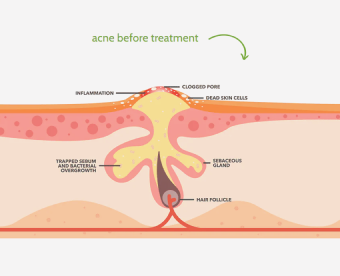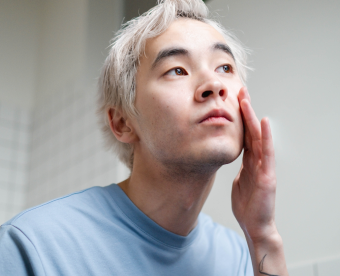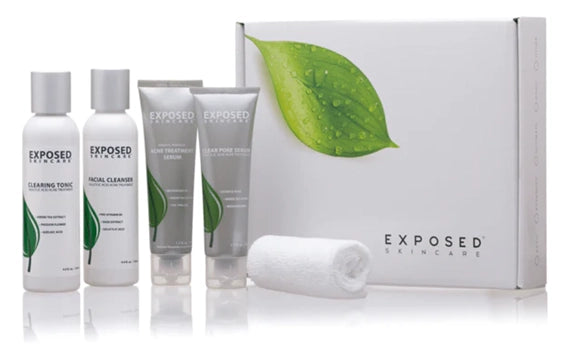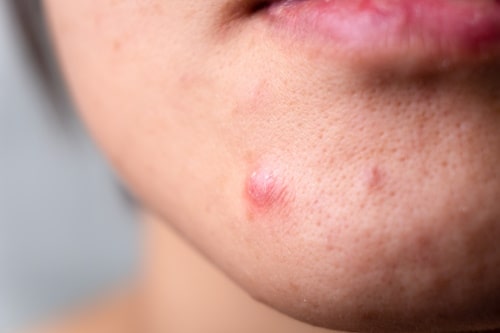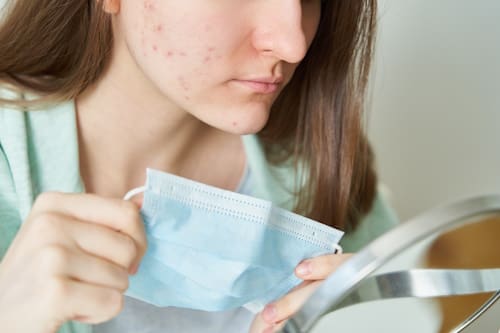A perfect skincare routine is akin to finding gold for many of us. Salicylic acid stands tall among the myriad of ingredients that have been touted as miracle workers for combating acne. This beta-hydroxy acid is a staple in many acne treatments.
But can salicylic acid cause acne? That's the burning question. Let's shed some light on this enigma as we uncover the roles of salicylic acid in skincare and understand its potential effects on acne.
Also read: How to choose the best acne treatment
Biggest Take-Aways:
-
Salicylic acid, a potent beta hydroxy acid, can effectively treat acne by exfoliating the skin, unclogging pores, and reducing inflammation, though it can also lead to skin purging, a temporary increase in breakouts.
-
Distinguishing between skin purging and breakouts is essential to understanding how salicylic acid works. Purging often occurs after introducing a new product and clears up after several weeks, while breakouts can happen at any time and may persist if the underlying causes are not addressed.
-
Overuse of salicylic acid can lead to skin dryness or irritation. It's crucial to start with products of low concentration and gradually increase if your skin responds well, emphasizing that salicylic acid is a powerful tool, but moderation is key in its usage.
-
Exposed Skin Care is a comprehensive skincare line that effectively combats acne, using salicylic acid and natural extracts to clear skin without causing irritation or skin purging, providing a balanced, gentle, and safe approach to daily acne treatment.

Understanding Salicylic Acid
What is Salicylic Acid?
Salicylic acid is a type of beta hydroxy acid known for its potency in treating various skin conditions. Thanks to its exfoliating properties, it is a key player in many acne treatments. Salicylic acid works by penetrating the pores of your skin and dissolving dead skin cells, effectively preventing them from clogging up the pores. This helps reduce the formation of blackheads and whiteheads, two types of acne.
How Does Salicylic Acid Work?
Salicylic acid softens keratin, a protein that forms part of the skin structure. This helps to loosen dry, dead skin cells and exfoliate the skin. This process aids in removing the top layer of skin, uncovering fresh new skin underneath and making your skin look radiant.
By unclogging pores and preventing the accumulation of dead skin cells, salicylic acid reduces the chances of blackhead and whitehead formation. Moreover, it can also have anti-inflammatory properties, reducing redness and swelling associated with inflammatory acne.

The Great Debate: Can Salicylic Acid Cause Acne?
While salicylic acid is a staple ingredient in many acne treatments, some people have raised concerns about whether it can cause acne. These concerns often arise when individuals notice a surge in breakouts after starting to use a product containing salicylic acid.
Understanding Skin Purging
The sudden breakout after starting a new skincare product like salicylic acid could actually be a process known as skin purging. This reaction can occur when you start using a new product, especially those with active ingredients like salicylic acid, retinoids, and alpha hydroxy acids, like glycolic and lactic acid.
When you apply these products, they expedite the skin's exfoliation process, bringing underlying clogs or non-visible comedones to the surface at a faster rate, thus causing a temporary breakout, which might appear as though your acne is getting worse before it gets better. However, this skin purge is generally temporary and should improve with continued use of the product as the skin adjusts to the new ingredient.
Salicylic Acid and Skin Irritation
While not directly causing acne, salicylic acid can sometimes lead to skin irritation, especially for sensitive skin or when used too often. This irritation can result in redness, dryness, and peeling of the skin. Moreover, if you're not careful, the irritated skin may trigger an inflammatory response, which can lead to more breakouts. So, while salicylic acid may not directly cause acne, it can lead to conditions that result in breakouts if used incorrectly or too often.

Salicylic Acid: Use with Care
The key to using salicylic acid without causing additional breakouts is to use it judiciously. Start with a low concentration, and use it every other day to see how your skin reacts. Depending on your skin type and sensitivity, you may gradually increase the frequency of application.
If you notice that your skin becomes irritated or excessively dry, consider reducing the frequency of use. Remember, keeping your skin hydrated is essential, as dry skin can produce more oil to compensate for the lack of moisture, leading to clogged pores and potentially more acne.
Salicylic Acid: A Double-Edged Sword in Acne Treatments?
Like many skincare products, salicylic acid can be both a boon and a bane. It's a powerful tool in the fight against acne, but only when used properly. Too little and it might not work, too much and it could irritate your skin, potentially leading to more breakouts. Hence, the question "Can salicylic acid cause acne?' is not straightforward.
Salicylic acid can lead to a surge in acne breakouts due to skin purging. However, it's not causing new acne, but rather expediting the process of existing acne coming to the surface. With consistent and careful use, salicylic acid generally leads to clearer skin over time.
Salicylic Acid: Beyond Acne Treatment
Salicylic acid is not just a potent acne-fighting agent. It has other skincare benefits that can help improve your skin's overall health and appearance. Here are a few:
- Exfoliation: Apart from preventing acne, the exfoliating properties of salicylic acid can help enhance your skin's overall texture and appearance. It effectively removes the outermost layer of the skin, revealing a brighter and more radiant complexion.

- Regulation of Oil: If salicylic acid is drying out your skin, it's essential to note that this beta-hydroxy acid can also help regulate sebum production. This feature can be particularly beneficial for individuals with oily skin.
However, while it’s considered safe, caution is needed when using salicylic acid daily. Overuse can lead to skin dryness or irritation, especially if your skin type is dry or sensitive. So, start by using products with a low concentration and gradually increase if your skin responds well.
Harnessing the Power of Exposed Skin Care
Exposed Skin Care is a comprehensive skincare line designed specifically to combat acne, using a synergistic combination of science and nature. Incorporating the acne-fighting power of salicylic acid with soothing natural extracts, it aims to clear skin without causing irritation or skin purging.
Here's why Exposed Skin Care might be your answer to clearer skin:
-
Multi-pronged Approach: Exposed Skin Care products don't just focus on removing acne. They also work on the process of the skin's healing and rejuvenation. Salicylic acid, a key ingredient in Exposed Skin Care, helps exfoliate the skin and unclog pores, while natural extracts like green tea soothe the skin and reduce inflammation.
-
Safe and Gentle: These products are formulated to be gentle enough for daily use, minimizing the risks of causing skin irritation, which might otherwise result from using too much salicylic acid.
-
Versatile: Whether you're dealing with blackheads, whiteheads, or severe acne, Exposed Skin Care offers a range of products to address various types of acne.
In essence, Exposed Skin Care offers a balanced approach to acne treatments, harnessing the potency of salicylic acid while ensuring the skincare line is safe and gentle for daily use. Always remember, clear skin is a journey, and each step you take brings you closer to achieving your skincare goals.
Conclusion
Salicylic acid emerges as a potent ally in pursuit of clear skin. However, it is vital to understand its potential side effects, like skin purging. Skin purging is a common, temporary reaction that signifies the effective exfoliation and cleansing of impurities, not to be confused with persistent acne breakouts. Each individual's skin response can vary, underscoring the importance of personalizing skincare routines.
Moderation is key in using salicylic acid. Starting with lower concentrations and gradually increasing can prevent skin dryness and irritation, especially in those with sensitive skin types. It's about finding that balance which allows this powerful beta hydroxy acid to combat acne effectively without causing unnecessary harm to the skin.
Lastly, products like Exposed Skin Care offer a comprehensive approach to acne treatment. Utilizing the strength of salicylic acid and calming natural extracts, they provide an effective, yet gentle skincare regimen. Remember, the journey to clear skin is not an overnight quest but a consistent commitment to understanding and caring for your skin's unique needs.
FAQs
1. What is salicylic acid?
Salicylic acid is a type of beta hydroxy acid that is commonly used in skincare products to help fight acne. It works by exfoliating the skin and unclogging pores.
2. How does salicylic acid work in fighting acne?
Salicylic acid softens keratin, a protein that forms part of the skin structure. This helps to exfoliate the skin by loosening dry, dead skin cells, thus unclogging pores and reducing the formation of blackheads and whiteheads.
3. Can salicylic acid cause acne?
Salicylic acid does not cause acne. However, it can cause skin purging, which is a process where acne breakouts can increase temporarily when you start using a new skincare product with active ingredients. It can also cause skin irritation, leading to more breakouts if used excessively or incorrectly.
4. What is skin purging?
Skin purging is a reaction that can occur when you start using a new skincare product, especially those with active ingredients. These ingredients accelerate the skin's exfoliation process, causing a temporary breakout surge.
5. How should I use salicylic acid to avoid skin irritation?
Start with a low concentration, and use it every other day to see how your skin reacts. Depending on your skin type and sensitivity, you may gradually increase the frequency of application. If you notice that your skin becomes irritated or excessively dry, consider reducing the frequency of use.

